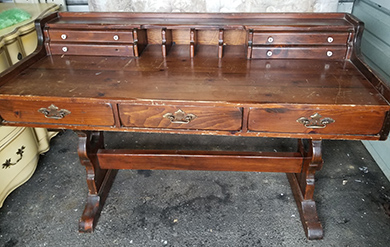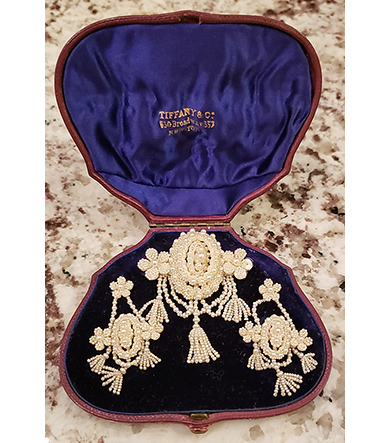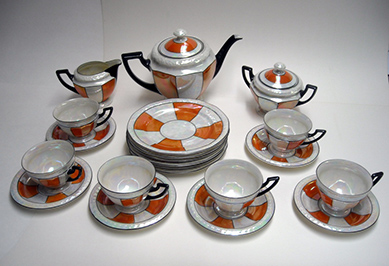 |
|
|||
 |
 |
|||
RINKER ON COLLECTIBLES — Column #1677 Copyright © Harry Rinker, LLC 2019 Questions
and Answers
QUESTION: In an abandoned storage unit that my mother bought, I found an odd-looking desk. It has trestle feet and a simple board stretcher that is joined to the legs through a mortise and tenon joint. A peg holds each tenon in place. The top has a flat box shape with a row of three drawers in the front. The back has a section consisting of two horizontal drawers on the left and right with an opening between them that features three turned spindles holding up the board going across the top. The desk drawers appear to be dovetailed and have wooden runners. However, the drawers have metal runners attached. There is a mark on the bottom of “2939’ which is crossed out in chalk and replaced with “2940.” Can you help me identify its exact age and value? – AC, West Reading, PA, Email Question 
ANSWER: You own a Colonial Revival desk made between 1920 and 1940. Colonial Revival furniture drew its inspiration from the historical furniture design styles of the period 1700 to 1830s. Rather than an exact copy of period pieces, Colonial Revival furniture mixed and matched historic design styles. Your piece’s trestle base is commonly found on late seventeenth and early eighteenth century tavern and kitchen tables. In addition to Colonial Revival desks, it often was used for Colonial Revival library and narrow hall tables. The desk portion combines a hodgepodge of styles to convey a country, mid-eighteenth century feel. Post-1945 Colonial Revival furniture is much closer in design to the historic period pieces. The desk’s value is as a useable piece of furniture. Its size makes it ideal for a small apartment. Since you did not provide measurements, I am assuming the desk top is between 45 and 50 inches wide. Its appearance is different enough to qualify it as a conversation piece. It has an Arts and Crafts appearance that blends well with modern Ikea and similar minimalist furniture. Your Colonial Revival desk has a secondary market value between $100.00 and $125.00. QUESTION: I received an elaborate pearl brooch and earring set in a Tiffany leather bound clam shell case. The brooch contains a central vertical oval cartouche with three layers of pearls, a five-petal flower to the left and right, each of which have a tassel pearl drop and are each connected by two pearl bands to a central pearl tassel drop. The earrings are similar in design and attach to the ear via a five-petal flower with two pearl bands attaching to the two side flowers. Two of the petals of the flower on the right side of the brooch have missing pearls. What must I do to authenticate this and determine its worth? – NE, Fort Atkinson, WI, Email Question 
ANSWER: It is not safe to assume that the name of a jewelry box means the piece in the box was sold by the jeweler. The quality of the piece has to match the level of the pieces made and/or sold by the jeweler. Your first step is to have a jeweler identify the quality of the pearls. Are they natural, cultured, or imitation pearls? If the latter, then the piece is not by Tiffany. Assuming the pearls are natural or cultured, the next question is should you have the piece restored before wearing (most definitely) or selling (debatable)? Restoration needs to be done by a very skilled jeweler, especially when it comes to matching the pearl quality and color. Send the photographs that accompanied your email to Tiffany. Ask if they can identify the origin and date of the case and whether the piece is one-of-a-kind or multiple-produced. Do not be surprised if you do not get an answer. Your email provided no information about how you acquired the piece. Did it descend through the family? Did you buy it at auction, from a dealer, or privately? What were you told when you acquired it? Appraisers do not operate in the dark. They need as much information as possible. Until the above information is available, it makes no sense to speculate on value. Once the above information is available, the next step is a search of reference books and auction sales. When authenticating, missing a step leads to misinformation. QUESTION: I have a few documents signed by Abraham Lincoln, one of which is a letter to Mrs. Bixby. The paper is extremely old and original looking. Who should I contact to have them authenticated? – LW, Email Question ANSWER: I can authenticate them for you. They are “meant to fool” reproductions produced by the Historical Documents Company of Philadelphia. The company’s motto is: Antiqued Parchment Replicas “That Look and Feel Old.” In 1926, Charles Promisio, a Philadelphia chemist, spilled a beaker of chemicals in his laboratory late in the day. Deciding to clean up the next morning, Promisio discovered that papers on which the liquid spilled appeared to have aged. The chemicals created a parchment, wrinkled look. Promisio founded the Historical Documents Company. It took him several years to perfect his 11-step technique to age paper. Promisio introduced his “antiqued” documents at the 1939 New York’s World Fair. The documents were a success. Promisio continued to add documents to his inventory. Promisio’s son and grandson have continued the business. It is still family owned. Historic sites, most notably sites managed by the National Park Service, and museums sell the Historical Documents Company replicas. Their affordability makes them a favorite among school children. [Author’s Aside: When visiting Independence Hall during a Cub Scout trip from my hometown of Hellertown, Pennsylvania, I bought a packet of colonial banknote replicas made by the Historical Documents Company. Thus, began a long association with products produced by the Historical Documents Company that were framed and passed by unscrupulous sellers as period objects.] A full list of over 500 historical documents wholesaled by the Historical Documents Company is on the company’s website www.histdocs.com. The Abraham Lincoln Writing Set (Item # 170) includes “four of his most moving and memorable pieces, including the Gettysburg Address, The Second Inaugural Address, the Emancipation Proclamation, and his letter to Mrs. Bixby. Who was Mrs. Bixby? She was a widow who lost 5 sons in the Civil War, and Lincoln’s letter to her is considered by many as ‘the most beautiful letter ever written.’” Your replica of the Mrs. Bixby letter has no value expect as an example of how not to be fooled by a good imitation. QUESTION: I own an Art Deco lusterware tea set consisting of six cups and saucers, a teapot, creamer and sugar. The pieces are decorated with vertical alternating red and pearl luster panels. The bottom of several pieces is marked with “P. A. L. T.” in an arch above an image of a discus thrower beneath which is “Czecho-Slovakia” in a reverse arch. What is the history and value of my tea set? – JL, Email Question 
ANSWER: Porzellanfabrik Turn, Adolf Laufer made your tea set. In 1917, the Ostereichische Ländrbank sold the former Eduard Stellmacher porcelain factory, founded in 1905 and located in Turn near Teplitz (Teplice), to Adolf Laufer. When purchased, the factory was producing coffee in cans, no doubt a wartime need. In 1919, porcelain manufacturing was reintroduced. Adolf Laufer made primarily affordable utilitarian household ceramics, many featuring a floral motif. It also produced large amounts of lusterware, especially for export. The United States importer MEPOCO was one of it major clients. Adolf Laufer ended production in 1936. Although 1920s/1930s luster, especially Japanese pieces, are a dreg on the market, your tea set benefits from its strong Art Deco motif. A comparable Adolf Laufer set with a green and orange motif sold recently for over $60.00. This color scheme is more desirable than your basic red and gray pearlized luster. The secondary market retail value of your set is between $40.00 and $45.00. Harry L. Rinker welcomes questions from readers about
collectibles, those mass-produced items from the twentieth and twenty-first centuries.
Selected letters will be answered in this column.
Harry cannot provide personal answers.
Photos and other material submitted cannot be
returned.
Send your questions to: Rinker on Collectibles, 5955 Mill
Point Court SE, Kentwood, MI 49512.
You also can e-mail your questions to
harrylrinker@aol.com.
Only e-mails containing a full name and mailing address
will be considered.
You can listen
and participate in
WHATCHA GOT?, Harry’s
antiques and collectibles radio call-in show, on Sunday mornings between 8:00 AM
and 10:00 AM Eastern Time.
If you
cannot find it on a station in your area,
WHATCHA GOT?
streams live on the Internet at www.gcnlive.com.
|
||||